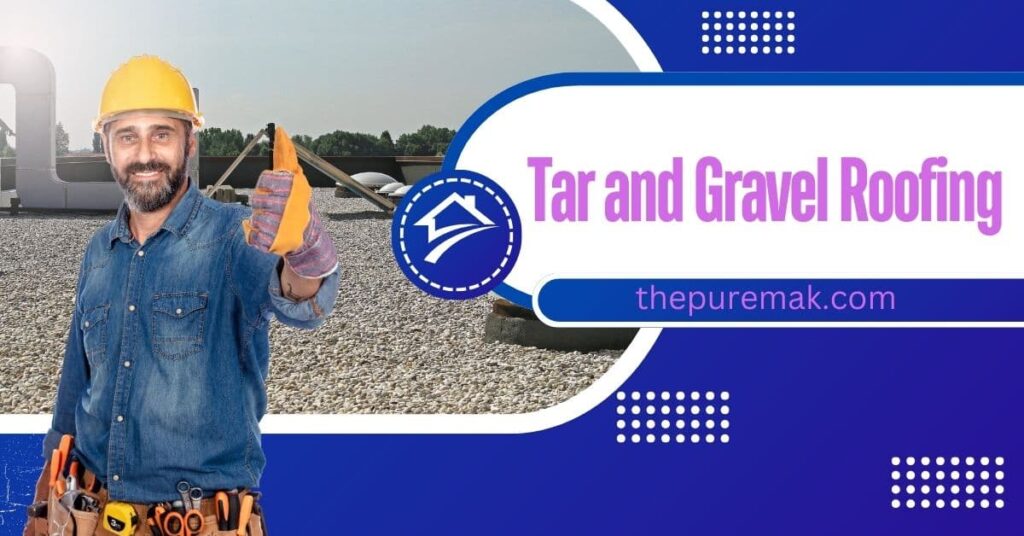
Contents
- 1 Introduction to Tar and Gravel Roofing
- 2 The Process of Installing a Tar and Gravel Roof
- 3 Benefits of Tar and Gravel Roofing
- 4 Drawbacks of Tar and Gravel Roofing
- 5 Comparing Costs: Tar and Gravel vs Other Roofing Options
- 6 Maintenance and Repairs for Tar and Gravel Roofs
- 7 Is Tar and Gravel Roofing Right for Your Home?
- 8 Conclusion
- 9 FAQs
- 10 1. How long does a tar and gravel roof last?
Introduction to Tar and Gravel Roofing
Have you ever wondered what’s underneath all those layers of protection when you gaze up at a roof? Built-up roofing (BUR), tar and gravel, is a sturdy yet traditional option for residential and commercial structures. Let’s explore the world of gravel and tar roofing to learn about its benefits and drawbacks, how to install it, how much it will cost, how to maintain it, and if it’s the best option for your house. So please grab coffee or tea and join us as we investigate this tried-and-true roofing solution!
The Process of Installing a Tar and Gravel Roof
Installing a gravel and tar roof is a very complex process. The existing roof must first be carefully cleaned and prepared to provide a smooth surface for the new materials. The roof’s surface is then evenly covered with hot tar.
The tar is then covered with layers of roofing felt while it is still hot. This creates a solid foundation for the upcoming addition of gravel, which aids with water runoff and provides UV protection.
When all the layers are in position, experts distribute the gravel uniformly over the top layer, ensuring the optimum distribution for the best results. This installation requires expertise and precision to provide a robust, long-lasting roofing solution for your house or building.
Benefits of Tar and Gravel Roofing
several homeowners go for tar and gravel roofing since it has several advantages. Its longevity is one of its key benefits. Roofs made of tar and gravel can resist severe weather, such as wind, snow, and rain, without rapidly deteriorating.
These roofs also last a long time—up to 20 to 30 years—if they receive the proper upkeep. They become a more affordable choice over time because of their durability and lower need for replacements than other roofing materials.
Additionally, tar and gravel roofs offer superior UV protection, which helps keep your home’s interior cooler during the sweltering summer months. The gravel layer can also be an extra insulation layer and enhance energy efficiency.
Another advantage of gravel and tar roofs is the minimal upkeep needed. They have a long lifespan if they receive routine maintenance and minor repairs as necessary.
Drawbacks of Tar and Gravel Roofing
Awareness of the disadvantages of gravel and tar roofing is essential. One drawback is that the materials utilised can weigh a lot, which might mean more structural support is needed. Furthermore, the hot tar application might make the installation clumsy and labour-intensive.
Another disadvantage is that severe rains may cause the gravel to shift or wash away over time, leaving bare patches on the roof. This might make the underlying layers more vulnerable to UV radiation and weather damage. Furthermore, if the layers’ seams are not kept up, leaks could appear between them.
Finding the exact spot where water seeps through a tar and gravel roof might be tricky for repairs. Furthermore, expertise and equipment may be needed to replace or repair damaged regions. Notwithstanding these disadvantages, a tar and gravel roof can add lifespan and durability to your house with the proper upkeep.
Comparing Costs: Tar and Gravel vs Other Roofing Options
A few factors must be considered when comparing the pricing of gravel and tar roofing with those of other solutions. Roofs made of tar and gravel are initially less expensive than slate or metal ones. However, because tar and gravel roofs require routine inspections and repairs, the long-term maintenance costs can increase over time.
Conversely, although metal or slate roofs may cost more upfront, they usually require less upkeep. Furthermore, these materials frequently last longer than gravel and tar roofs, which might save money over time.
When selecting a roofing material for your house, consider the initial outlay and ongoing maintenance costs. Also, consider longevity, energy efficiency, durability, and aesthetic appeal.
Maintenance and Repairs for Tar and Gravel Roofs
Maintenance is necessary for a tar and gravel roof to last longer and function at its best. Routine inspections are essential to find problems early on. Debris, such as leaves and branches, can be removed to avoid water pooling, which can result in leaks.
The waterproofing qualities of the roof should be maintained with regular sealant applications. Before they worsen, any cracks or blisters need to be treated right away. In damaged places, repairs could entail reapplying gravel or adding more layers of tar.
It is advised that you have a professional roofing contractor inspect your gravel and tar roof at least once a year for upkeep. They can spot possible issues that the untrained eye could miss.
Your tar and gravel roof can last for many years if you maintain it proactively and immediately take care of repairs.
Is Tar and Gravel Roofing Right for Your Home?
Are you considering roofing your house using tar and gravel? Before making this choice, you must evaluate a few crucial elements. Consider the local weather. Roofs composed of tar and gravel are renowned for their resilience to inclement weather, such as persistent rain or snowfall.
Additionally, assess your roof’s slope. Tar and gravel roofs are an excellent option for flat or low-sloped rooftops because of their seamless installation. Take into account your home’s beauty as well. Although tar and gravel roofs have a classic appearance, not all architectural styles will work well with them.
Consider the need for maintenance as well. Routine maintenance is essential, and maintenance is necessary to extend it. It is vital because these roofs can be inexpensive initially but may need more frequent maintenance.
The suitability of tar and gravel roofing for your house will rely on several situation-specific elements.
Conclusion
Remember that every house is different as you consider the benefits and drawbacks of gravel vs tar roofing. Before choosing, consider your location, spending limit, and long-term maintenance requirements. Although labour-intensive, the installation technique yields durability. When appropriately maintained, tar and gravel roofs are renowned for their resilience to inclement weather.
Maintenance is essential to extending the life of your gravel and tar roof. Routine inspections and repairs must avoid water leaks and damage. Even though tar and gravel roofs may initially cost more than other roofing materials, their lifespan may make them a more affordable option over time.
The appropriate tar and gravel roofing for your house requires several situation-specific elements. Before deciding, get an accurate needs assessment from an expert roofer.
FAQs
Are you concerned about gravel and tar roofing further? Look over these commonly asked queries:
1. How long does a tar and gravel roof last?
Tar and gravel roofs can endure up to twenty-five years with proper care.
2. Is tar and gravel roofing energy-efficient?
The layers’ insulating qualities can aid in controlling interior temperature, even though they’re not as energy-efficient as some contemporary solutions.
3. Can I walk on a tar and gravel roof?
You can stroll on a tar and gravel roof, but keeping your distance is advisable to avoid damaging the surface.
4. Are there any eco-friendly alternatives to tar and gravel roofing?
Cool or green roofs provide superior environmental benefits and are more sustainable solutions.
5. How often should I have my tar and gravel roof inspected?
To identify any possible problems early on, routine inspections should be conducted every one to two years.
Consider its costs, benefits, upkeep needs, and adaptability to determine whether tar and gravel roofing is the best option for your home. This conventional method can be just what your property needs if you value affordability in installation expenses, low maintenance upkeep, and longevity!






